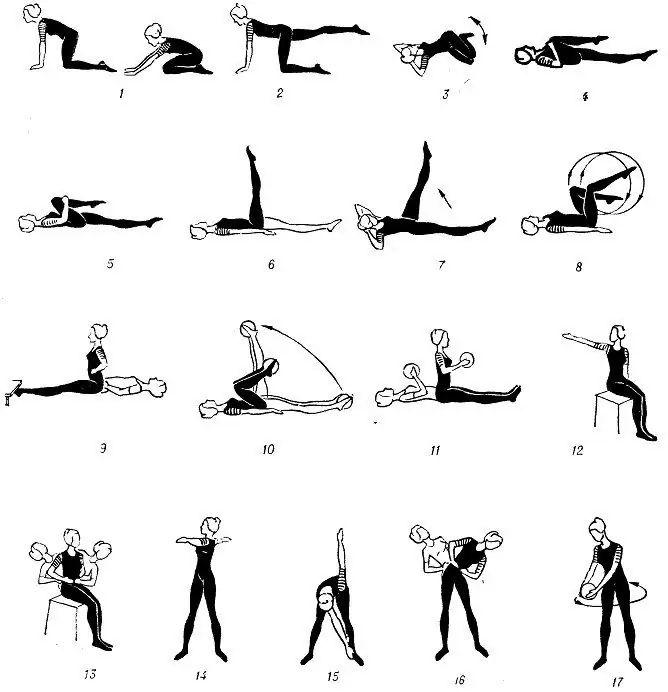- Author Rachel Wainwright [email protected].
- Public 2024-01-15 19:51.
- Last modified 2025-11-02 20:14.
Spastic constipation
The content of the article:
- Causes and risk factors
- Forms of constipation
- Stages of spastic constipation
- Symptoms of spastic constipation
- Features of spastic constipation in children
- Diagnostics
- Treating spastic constipation
- Possible complications and consequences
- Forecast
- Prevention
Spastic constipation is a common disorder of motor and evacuation function of the intestine, which is caused by muscle spasms in certain areas of the large intestine.

Source: zapora.net
Spastic constipation in adults is a very common pathology, it is found in 30-50%, the incidence in children is somewhat lower - 20-25%. The elderly are more prone to spastic constipation. During pregnancy, difficulties in defecation of a spastic nature are noted in 70-80% of women, in 30% they persist in the postpartum period.
Causes and risk factors
The causes of spastic constipation in most cases are impaired intestinal motility, weakening the urge to defecate. Less often, the pathological process develops against the background of neurovegetative and endocrine diseases, intestinal neoplasms.
Risk factors include:
- taking certain medicines (especially strong laxatives);
- pregnancy;
- poor nutrition - excessive consumption of protein-rich or spicy foods, fiber deficiency;
- chronic intoxication of the body (including industrial hazards - contacts with compounds of mercury, lead, etc.);
- artificial feeding in infants;
- the presence of bad habits;
- lack of physical activity;
- excessive mental stress;
- violation of the daily routine, non-compliance with the diet.
Forms of constipation
Depending on the etiological factor, constipation is divided into the following types:
- functional dyskinetic (spastic and hypotonic);
- alimentary;
- organic;
- conditioned reflex;
- endocrine;
- intoxicating;
- iatrogenic.
Spasmodic constipation, in turn, can be acute or chronic.
Stages of spastic constipation
Depending on the severity of clinical manifestations during spastic constipation, three stages are distinguished:
- Compensation - defecation occurs once every 2-3 days.
- Subcompensation - bowel emptying once every 3-5 days.
- Decompensation - delay in bowel movements for 10 days or more.
Symptoms of spastic constipation
The main symptom of spastic constipation is delayed and difficult bowel movements. The patient requires significant tension in the abdominal and pelvic floor muscles. In addition, it is noted:
- feeling of incomplete bowel movement after a bowel movement;
- bloating (may be accompanied by palpitations, pain in the heart);
- sharp pain and / or a feeling of fullness in the lower abdomen (usually disappear after passing gas or defecation, practically absent during a night's sleep);
- decreased appetite.
Feces often take the form of small hard lumps (the so-called sheep feces), in addition, feces can be ribbon-like, cord-like, bean-shaped, often an admixture of mucus is found in the feces. With spastic constipation, a small amount of stool is excreted.
In addition, patients complain of weakness, rapid fatigue, increased irritability, and persistent headaches. The color and appearance of the skin changes, the skin acquires a yellowish tint, becomes pale, flabby, and loses its elasticity.
Features of spastic constipation in children
The normal frequency of bowel movements in children varies with age. In newborns who are breastfed, the frequency of bowel movements usually corresponds to the frequency of feedings (6-7 times a day). By the time of the introduction of complementary foods (4-6 months), the number of bowel movements is reduced to twice a day. In formula-fed babies, bowel movements usually occur once a day. Children from the second year of life normally have bowel movements once or twice a day. With a more rare bowel movement, you can suspect that the child has constipation.

Source: malyshzdorov.ru
Up to six months of age, the consistency of a child's feces is normally mushy, from six months to two years it can be mushy or shaped, after two years the stool is decorated. Constipation may be indicated by hard stool or frequent bowel movements in small portions of formalized stool.
Coprostasis causes the development of intestinal colic, flatulence, a feeling of pressure in the anus. When injured by dense feces of the mucous membrane of the anal canal, an admixture of blood in the form of scarlet veins is found in the feces. After a long delay in bowel movements, children sometimes develop encopresis (paradoxical fecal incontinence).
Common symptoms of spastic constipation in children include nausea, anorexia, pustular eruptions and acne on the skin, and anemia.
Diagnostics
For the diagnosis of spastic constipation, complaints and anamnesis are collected, an objective examination, instrumental and laboratory examination.
On palpation, pain along the intestines is determined. The relaxed cecum and spasmodic sigmoid colon, sometimes fecal stones in the sigmoid colon, are well palpated.
Instrumental methods are used:
- sigmoidoscopy (visual examination of the mucous membrane of the rectum and some parts of the sigmoid colon using a sigmoidoscope);
- irrigoscopy (X-ray examination of the large intestine with the introduction of a contrast agent into it);
- fibrocolonoscopy (endoscopic examination of the inner surface of the large intestine).
In some cases, ultrasound examination of the stomach, pancreas, liver, intestines is performed; general X-ray of the abdominal cavity, enterocolonoscintigraphy (with its help, the motor function of the intestine is assessed). Children with spastic constipation may require consultation with a neurologist with echoencephalography and electroencephalography.
Laboratory tests are prescribed: analysis of feces for dysbiosis and helminth eggs, coprogram, general and biochemical blood tests.
Differential diagnosis of spastic constipation is carried out with intestinal diseases with similar symptoms, including intestinal obstruction, which, in turn, can be a complication of acute myocardial infarction.
Treating spastic constipation
In most cases, correction of the diet and diet is sufficient to eliminate spastic constipation. Patients are shown a diet high in fiber and fermented milk products.
It is recommended to include in the diet dishes from vegetables and fruits in mashed or mashed potatoes, ground dried fruits, boiled meat and fish, low-fat broths, kefir, natural yogurt, yogurt, cottage cheese, wholemeal bread, biscuit biscuits, hard pasta wheat, herbal tea, fresh juices.
Fiber content in food:
| Food | Fiber content, g | Food | Fiber content, g |
| Blackberries, 1 tbsp | Almonds, 24 pcs. | 4 | |
| Pear, 1 pc. | five | Peanuts, 28, pcs. | |
| Apple or orange, 1 pc. | Peanut butter, 2 tablespoons l. | ||
| Dried figs, 2 pcs. | Cashews, 18 pcs. | ||
| Kiwi, 2 pcs. | Tofu (soy cheese), 100 g | ||
| Dried apricots, 5 pcs. |
Legumes, 1.5 tbsp (boiled): |
||
| Banana, 1 pc., Or 1/4 cup raisins | Dark beans or peas | ||
| Blueberries or strawberries, 1 tbsp. | Lentils | ||
| Plums, 5 pcs., Or plum juice, 1 tbsp. | Canned chickpeas | ||
| Peach, 1 pc., Or grapefruit, 1/2 pc. | 0.5 |
Bread: |
|
| Wheat, whole flour, 2 slices | |||
| Boiled vegetables: | White bread, 2 pieces | ||
| Peas, 1/2 tbsp. |
Hot porridge (1 tbsp. L.): |
||
| Broccoli, 1/2 cup | Oat bran | ||
| Whole baked potatoes, 1 pc. | Millet | five | |
| Asparagus, 6 sprouts | Oatmeal | ||
| Raw carrots, 1 pc. | Semolina | ||
| Cauliflower, 2/3 tbsp |
Boiled cereals and pasta: |
||
| Corn, 1/2 tbsp. | Whole wheat pasta, 3/4 cup | ||
| Sliced salad, 2 tbsp. | Popcorn, 4 tbsp. l. finished product | ||
| Spinach Kale, 1/2 cup | Ordinary pasta, 1 tbsp. | ||
| Brussels sprouts, 1/2 tbsp | Brown rice, 3/4 tbsp. | ||
| Tomato, 1 pc. | White rice, 3/4 tbsp. | 0.5 |
* Note: numbers less than 1 have been rounded to the nearest 0.5 g.
Patients with spastic constipation are shown an abundant drinking regimen. The consumption of fresh bread, sweets, sausages, salted fish, fatty meats, mushrooms, legumes, milk, cocoa, smoked and canned foods, spices, and alcoholic beverages should be limited or completely eliminated. During an attack of spastic pain, it is recommended to refrain from eating.
To relax the spasmodic intestinal muscles, antispasmodic drugs may be prescribed. After relieving intestinal spasm, mild laxatives (including in the form of microclysters) are used to gently excrete feces. In some cases, cleansing enemas are shown, and the temperature of the solution should be moderate, since the introduction of cool liquid can aggravate the spasm of the intestinal muscles. Oil enemas, oil-water mixtures, decoctions of mint or lemon balm are also effective. Treatment of spastic constipation can be supplemented with warm baths, paraffin and pine compresses on the abdomen.
If the patient has high psycho-emotional lability, sedatives and / or tranquilizers are prescribed.
For spastic constipation, herbal medicine can be used (infusions and decoctions of mint, wild flax, horsetail, yarrow, fennel, licorice root, calamus root, St. John's wort, tansy).
Possible complications and consequences
Against the background of spastic constipation, secondary colitis, inflammation of the sigmoid and rectum (proctosigmoiditis), enteritis, the formation of fecal stones, hemorrhoids, rectal fissures, enlargement and elongation of the large intestine (acquired megacolon), intestinal obstruction, malignant neoplasms of the large intestine and / or rectum.
Forecast
With timely diagnosis and properly selected treatment, the prognosis is favorable. In elderly patients and bedridden patients, it worsens.
Prevention
In order to prevent the development of spastic constipation, it is recommended:
- balanced nutrition, a sufficient amount of plant fiber in the diet, adherence to the diet;
- compliance with the drinking regime;
- regular physical activity, rejection of a sedentary lifestyle;
- avoidance of irrational use of medicines;
- development of stress resistance;
- rejection of bad habits.
YouTube video related to the article:

Anna Aksenova Medical journalist About the author
Education: 2004-2007 "First Kiev Medical College" specialty "Laboratory Diagnostics".
The information is generalized and provided for informational purposes only. At the first sign of illness, see your doctor. Self-medication is hazardous to health!






